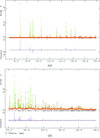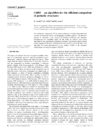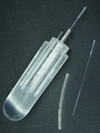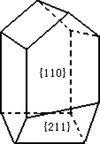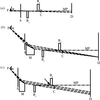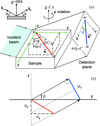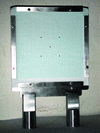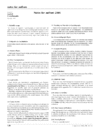issue contents
February 2006 issue

Cover illustration: Curvature mapping onto a surface drawn using the program Curvis. Courtesy of S. Piotto & R. Nesper [J. Appl. Cryst. (2005), 38, 223-227].
research papers
Download citation


Download citation


Open  access
access
 access
accessThe determination of the structure of the quaternary alloy Zn0.6Mn0.4In2S4 was accomplished by means of powder synchrotron X-ray diffraction, high-resolution microscopy and convergent-beam electron diffraction.
An efficient and robust algorithm for the comparison of periodic structures is presented, which is based on the mapping of the point patterns of the two structures into each other.
A correlation of the curvature of lattice planes with the growth mode of SiC crystals and the shape of the isotherms in the growth furnace is given and explained by small-angle grain boundaries.
Powder diffraction data for a nanocrystalline ceria sample used in a recently concluded round robin were analysed by two full-pattern techniques, based on profile modelling and on profile fitting. Line profile analysis results, mostly concerning the crystalline domain size distribution, are discussed and compared with those given by transmission electron microscopy.
Open  access
access
 access
accessThis manuscript reports the absolute calibration of a low-flux small-angle X-ray scattering instrument, using different standard samples. Following the comparison of the results, the suitability and relative merits of standards are discussed.
Oriented sols for fiber diffraction are made using much smaller quantities than conventional methods, and by a method suitable for use with hazardous materials and labile assemblies.
An X-ray single-crystal diffraction study of an iron ludwigite has been performed at 300 and 15 K. The structure at 300 K was confirmed as belonging to space group Pbam, whereas at 15 K the structure was solved in space group Pnma.
Open  access
access
 access
accessEnergy separation of neutrons scattered at small angles from silicon using time-of-flight techniques
The time-of-flight technique is used to separate the elastic and inelastic contributions to neutron small-angle scattering from silicon single crystals. The inelastic scattering of 8 Å neutrons by silicon is shown to arise from phonon annihilation involving an Umklapp process.
The growth mechanism and defect formation of the {110} faces of manganese mercury thiocyanate crystals were investigated by atomic force microscopy. A dislocation-controlled mechanism and a two-dimensional nucleation mechanism operate simultaneously during growth.
A new algorithm for extending partial protein models is presented. This alogorithm simulates the operations performed by crystallographers for model building, using computer graphics in the refinement process.
Various SAXS cameras with a block collimation system are simulated and their theoretical performance is compared with the experimental data.
The inverse Greninger–Troiano relation between f.c.c. and b.c.c. crystals is shown to complete the Bain circles formed by the common correspondence relationships. There is experimental evidence for this relation in the plessite regions of the Gibeon meteorite.
Open  access
access
 access
accessGeometrical aberration is exploited in order to perform crystallographic phase imaging and reconstruction of the hidden interior of an object from neutron time-of-flight diffraction.
An analytical method to obtain symmetric peak profiles from experimental data with asymmetric peak profiles measured with a high-resolution synchrotron X-ray powder diffractometer has been developed. The method has successfully been applied to the diffraction intensity profiles of a ZnO powder sample measured with a synchrotron X-ray powder diffractometer on beamline BL4B2 at the Photon Factory.
short communications
Reliability of automatic indexing of electron diffraction patterns is discussed. It is shown that, for certain crystallographic directions of the direct electron beam, an automatic procedure leads to misindexing.
The limitation of automatic indexing of electron diffraction patterns raised by Morawiec & Bouzy [(2006). J. Appl. Cryst. 39, 101–103] is discussed. The theoretical problem related to the famous 180° ambiguity may be surmounted by adequate technical improvements. Three solutions to avoid misindexing are briefly described.
A technique, using a symmetric reflection via azimuthal rotation of a sample, is presented for quantitative determination of the orientations and locations of dislocations in single crystals.
computer programs
The TLSMD web server accepts an input protein structural model in either PDB or mmCIF format, and returns an analysis of possible multi-group TLS descriptions of the bulk motions derived from the distribution of thermal parameters in the input model. These multi-group TLS models may be used as a starting point for further crystallographic refinement, or as the basis for analyzing inter-domain and other large-scale motions implied by the crystal structure.
A new software package for fast diffraction image analysis, providing image statistics and facilitating automated crystal screening, is presented.
laboratory notes
A sample chamber for temperature-dependent GISAXS measurement of microstructure in polymer materials is described.
A method of rapid capillary sample loading of dry powder or polycrystalline slurry for powder diffraction has been developed, in which the sample is packed against a filter embedded in the capillary tube.
Shielding of unwanted Bragg diffraction is performed by tiny permanent magnets made from SmCo5.
international union of crystallography
Free 



 journal menu
journal menu











